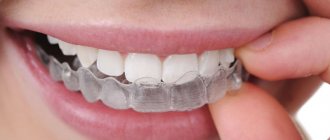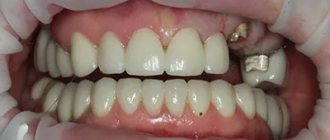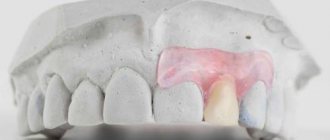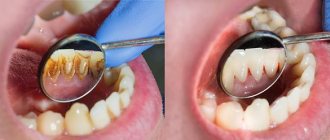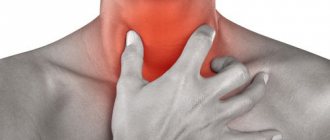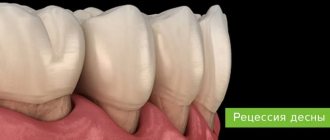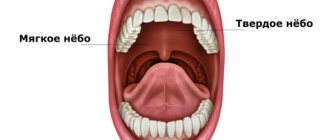Removable dentures - what are they?
Removable dentures are devices that partially or completely replace lost teeth. A distinctive feature of removable structures is the ability for the patient to remove and put them on independently. This feature unites all types of removable dentures with a significant variety of types and models.
Despite the advantages of modern fixed prosthetics, removable dentures also have their advantages:
- relatively low price;
- ease of manufacture and operation of the orthopedist;
- the ability to choose a manufacturing material that is suitable in price and quality;
- the ability to restore any defect in the dentition;
- lightness of the prosthesis, the ability to choose the desired shade of material;
- no need to prepare healthy teeth for prosthetics;
- the ability to repair a damaged model in a dental laboratory;
- ease of care.
Removable dentures solve the problem of restoring the aesthetic and chewing function of teeth when they are lost and it is impossible to establish a fixed model, and therefore increase the quality of human life.
Adhesive fixed bridge prosthesis
An adhesive fixed denture got its name due to the peculiarities of fixation on the supporting teeth. To connect it with living tooth tissues, adhesion is used, that is, “sticking” technology. For reliable bonding, the prosthetist uses a dental primer, bond, some types of acids (for example, phosphoric acid), chemical or light-curing cement.
Adhesion helps to secure the ceramic tooth and onlay processes to the supporting teeth without removing the roots and grinding away a large layer of its enamel.
Structure of an adhesive dental bridge:
- main abutment tooth;
- side linings in the form of processes (petals), onto which a fixing compound is applied.
The average lifespan of an adhesive dental bridge is up to five years.
Indications for removable prosthetics
Removable dentures are installed when:
- the absence of several teeth in the dentition and the impossibility of fixed prosthetics;
- the patient’s refusal of fixed prosthetics;
- complete loss of teeth - adentia;
- loss of a large number of teeth (immediate denture);
- loss of one tooth (aesthetic prosthesis);
- for infectious-inflammatory and degenerative-dystrophic diseases of periodontal tissues (periodontitis or periodontal disease);
- severe general diseases that are contraindications for fixed prosthetics;
- individual intolerance to metal structures.
Removable dentures will be an ideal option if you lose several lateral teeth in a row on both sides or if you lose central teeth while keeping the lateral ones. This type of prosthetics is also very suitable for edentulous patients, if the patient refuses implantation.
Clasp apparatus
Experts are confident that the only thing better than a removable structure for the upper or lower jaw is a fixed analog or clasp denture. The latter option is recommended for use in case of partial loss of teeth. It is based on a metal frame and is fixed on the supporting elements of the row.
It is distinguished by its compact size, which guarantees a high degree of comfort. The product rests on a thin metal arc. It is secured with clasps (hooks), attachments (micro-locks), and telescopic crowns. This model is more expensive, but its price is quite reasonable.
Disadvantages of removable prosthetics
Despite the simplicity and ease of installation of removable dentures, these designs have more disadvantages than advantages:
- the inability to create a uniform load on the jaw tissue, which gradually leads to their atrophy (decrease in volume) and the need to change the model (limited validity period);
- insufficiently reliable fixation in the oral cavity, which often creates problems when chewing and unclear speech;
- difficult process of getting used to wearing; some sensitive people cannot get used to a foreign object in the oral cavity due to injury to soft tissues;
- It is impossible to carry out prosthetics immediately after tooth extraction, as is the case with one-stage implantation.
Removable dentures should be installed only when there are no other prosthetic options, since there are contraindications for installing bridges or prosthetics on implants.
Prices
| Service | Price |
| Removable acrylic (plate) dentures | from 15,200 rub. |
| Dental bridges | from 25,800 rub. |
| Nylon dentures | from 34,900 rub. |
| Clasp dentures | from 48,500 rub. |
| Complete dental prosthetics on implants | from 215,000 rub. |
| All-on-6 prosthetics | from 221,000 rub. |
To avoid possible misunderstandings, please clarify the cost of services in clinics with the administrator or during a consultation with a doctor. Prices on the website are not a public offer.
Sign up for a consultation
Types of removable prosthetics
Features of dental prosthetics with removable dentures largely depend on the type of structure, material of manufacture, and method of fixation in the oral cavity.
By type of design
There are two types of models: plate and clasp.
Plate removable dentures
Lamellar (lamellar) are the very first models. Their design is very simple, it consists of a base - plastic, repeating the relief of the gums and palate and artificial crowns installed on them. Constructions of this type are divided into:
Complete and partially removable plate dentures
- complete removable dentures – in case of complete absence of teeth;
- partially removable dentures – if some of the teeth are preserved; one of the modern options is sandwich dentures that do not cover the palate;
- immediate dentures (butterflies, micro dentures) – for 1 – 2 adjacent teeth.
Installation of these models in the oral cavity is easy: the orthopedist makes an impression of the jaw, a model is made from it in a dental laboratory, the orthopedist first tries it on, then installs it. The patient fixes the model by clenching his teeth. Partially removable models are fixed on the preserved teeth using special clasps. After which the patient begins to gradually get used to the new design. Caring for the plate model is quite complicated; it is carried out daily by the patient himself and professional cleaning is carried out twice a year.
- Pros: lightweight, easy to install prosthesis.
- Cons: you have to change it often (at least once every 3 years, sometimes more often), the fixation is unreliable.
Clasp removable dentures
Clasp dentures are modern partially removable dentures, consisting of a plastic base with artificial crowns installed on it, an arched metal frame and hook-clasps fixing the structure on the supporting teeth. A metal arch (clasp) allows you to create the desired load on the jaw tissue. A modern option is the metal-free Quadrotti clasp, where all parts are made of high-strength plastic.
Conventional clasp prosthesis
Metal-free Quadrotti
Installation is more difficult, since it is necessary to prepare the supporting teeth. Caring for the clasp does not require any special skills; it is enough to do it regularly.
- Pros: proper distribution of the load on the jaw prevents bone tissue atrophy, so the structure can last a long time (at least 5 years, but more often much longer), there is no massive plastic base that disrupts taste, lightness and beautiful appearance, reliable fixation in the oral cavity.
- Cons: requires getting used to, sometimes the fixing elements are visible when you smile, high cost.
By fixation method
A full plate removable denture is attached to the oral cavity as follows:
- by removing air between the orthopedic structure and the tissues in the oral cavity while clenching the jaws; this design is called “suction cup”; good fixation is achieved only if all the bends of the structure fully correspond to the bends of the patient’s oral tissues;
- using special fixing adhesives and creams, strips and gaskets.
A partially removable denture is fixed on the supporting teeth using hooks (clasps). Clasp removable dentures are fixed in different ways. According to this principle, all clasp partial removable dentures are divided into the following designs:
Clasps on clasps, attachments and telescopic crowns
- on clasps - hooks securely fix the model on the supporting teeth, but can be noticeable when smiling;
- on attachment locks - complex locks are fixed on supporting teeth covered with crowns, so they are practically invisible; the design is complex to manufacture and therefore expensive;
- on telescopic (retractable) crowns - the most difficult manufacturing option, requiring grinding of the supporting teeth and installing crowns on them.
Conditionally removable models on implants are screwed to titanium roots installed during implantation. They can be removed by the dentist during medical examinations for cleaning. The patient cannot remove them on his own, which is why they are called conditionally removable.
By material
The very first models were made from rubber. Today, plate structures are made from various types of plastics. Certain requirements have been developed for plastic dental materials. They should be:
- durable, able to withstand chewing loads;
- securely connecting to artificial crowns;
- not deformed during wearing;
- non-irritating to periodontal tissues;
- without toxic or allergic effects.
The following materials meet these requirements (partially or fully):
Acrylic removable dentures for teeth
Acrylic is a type of plastic that has replaced rubber in the manufacture of removable dentures. It became widespread in the late 30s of the last century. It causes allergies due to the component contained in the coloring substance, but acrylic without color is also available, which is less aesthetically pleasing, but does not cause allergies.
- Pros: an acrylic prosthesis has a number of advantages compared to a rubber one: it is more durable, aesthetically pleasing, and it is easy to make an inexpensive removable model from it.
- Disadvantages: the material is not elastic enough and during the process of getting used to it often causes tissue irritation;
- during the entire time of wearing, it releases a non-protein substance (monomer), which combines with tissue proteins and causes toxic-allergic reactions;
- The high porosity of acrylic contributes to the accumulation of bacteria on its surface and the development of infectious and inflammatory processes in the oral cavity.
Nylon Removable Dentures
Nylon - removable models began to be made from this type of plastic in the mid-80s of the last century.
Pros - nylon prostheses are more plastic, do not have pronounced porosity, are non-toxic, and hypoallergenic.
Minuses:
- excessive flexibility creates problems in the form of uneven distribution of load and gradual atrophy of the jaw bone tissue;
- the device is not always securely held in the oral cavity.
Acry-Free dentures
Acry-Free (acrylic-free plastic) is a modern thermoplastic material that does not contain acrylic.
- Pros: hypoallergenic, durable, elastic, fits perfectly to the tissues in the oral cavity, is smooth (bacteria do not linger on it), does not irritate the tissue, structures made from it can look like natural ones.
- The downside is the higher cost.
The following materials are used for the manufacture of clasp models:
- Plastic - for the manufacture of the base, mainly high-strength types of plastic manufactured using high technology are used. From these types of plastic it is also possible to make a completely metal-free clasp dental prosthesis Quadrotti. The most famous materials: acetal (acetate plastic) - a modern plastic that has increased resistance to stress, while not causing allergic reactions and tissue irritation; has a wide selection of color shades, very aesthetic; minus – high cost;
- Dental D (white plastic) – an even more durable, elastic material with excellent aesthetic qualities; minus - expensive.
Which material is better and will last longer?
The degree of reliability of fixation, comfort and aesthetics during use depends on the material from which removable dentures are made.
The main requirements for them include:
- strength;
- biocompatibility with human tissues;
- lack of toxicity, allergenicity, effects on taste and olfactory receptors.
Acrylic is the most popular and affordable material. It does not change its properties over time; acrylic dentures have good aesthetics. But it has a porous structure and can accumulate bacteria that cause inflammation.
Nylon is a lightweight and flexible material. Does not cause an allergic reaction and does not accumulate bacteria. Although it is durable, due to its softness and elasticity it quickly becomes unusable, so nylon dentures perform a good aesthetic function, but do not cope well with their intended purpose, chewing.
Acry Free is a modern material for removable dentures (translucent plastic that does not contain acrylic). It is elastic, does not injure the mucous membrane, and structures made from it are resistant to mechanical stress. This material is suitable for patients with allergies to metal or acrylic and with hypertonicity of the masticatory muscles. The service life of dentures made from it is longer than that of acrylic ones. The cost is higher than acrylic and lower than nylon and clasp.
The best removable dentures
After the examination, the orthopedic dentist advises the patient which removable dentures to choose. It is worth listening to these recommendations, since all types of prosthetics have their own indications and contraindications.
Removable dentures for complete absence of teeth
If the patient is completely missing all the teeth in the dentition, then the best option would be conditionally removable prosthetics on implants - all on 4 or all on 6. 4 or 6 titanium roots are implanted into the jaw, after which a model is screwed onto them, completely replicating the anatomy of the jaw. Such teeth are practically no different from natural ones. They do not require daily removal for cleaning; regular oral care and professional cleaning of the model every six months are sufficient. The only disadvantage of conditionally removable prosthetics is its relatively high cost.
If full implantation is not affordable, you can also install a complete removable denture with suction cups. To do this, on the advice of a doctor, you need to select the most suitable plastic for making the model, carefully take an impression so that all the anatomical features of the jaw and oral tissues are fully reflected in the future design. Then, when the jaws are clenched, air is displaced, the structure collapses with the tissues, sticks to them and provides fixation. This type of design can be taken off and put on daily.
To install a removable denture in the absence of teeth, it is not recommended to use nylon structures, since they cannot fully support the chewing function and do not prevent atrophy of the jaw bone tissue.
With partial absence of teeth
The question of which removable dentures are better for incomplete edentia is also decided by the doctor. The best option would be the metal-free clasp Quadrotti model. This is a unique design, very reliable, correctly regulating the load on the tissue. The only negative is the high cost.
Option number two is a regular clasp model using metal. The clasp is also reliable, aesthetically pleasing and does not cause any discomfort when worn. The downside is that it's also not cheap.
A budget option is a plate model made of acrylic. It is also reliable, but not durable and often causes toxic-allergic reactions. To avoid allergies, you can install a colorless acrylic structure, which does not have an entirely aesthetic appearance. If 1–2 teeth are missing, then a butterfly microprosthesis made from any type of plastic can be installed.
Which removable denture is best for the upper and lower jaw?
Any option is suitable for the upper jaw, since there is a significant space behind the back surface of the teeth that allows removable dentures of any type to be securely fixed. But it is still better to give preference to conditionally removable prosthetics on implants. A removable denture for the upper jaw can also be a clasp denture.
Prosthetics on the lower jaw are more problematic; there is no necessary space for fixation, therefore, deciding which removable dentures are better should be entrusted to an orthopedist. The options to choose from are conditionally removable prosthetics on implants and any type of clasp.
Why is complete absence of teeth dangerous?
It is necessary to restore the dentition in case of edentia, and this must be done as quickly as possible. The absence of even one tooth can cause serious health problems, let alone complete edentia.
· Bone tissue atrophy. Without the necessary load on the jaw, the bone tissue begins to thin out, and subsequently it will be very difficult to restore chewing function through implantation. You will have to specifically build up the bone tissue surgically, and this is an additional waste of money and time.
· Disorders of the digestive system. A person will have to give up many foods, and poor digestion of poorly chewed food will negatively affect the condition of the gastrointestinal tract.
· Changes in appearance. Distortion of the oval of the face, protrusion of the chin, sunken cheeks and compressed lips are characteristic facial features of a patient with complete edentia.
· Distortion of speech. Teeth are involved in the formation of sounds. Their absence greatly affects articulation.
As a result, speech becomes lisping and the person cannot pronounce a number of sounds.
Such troubles form a huge number of complexes in a person. His quality of life and communication skills are declining. The only way to get rid of all restrictions is complete prosthetics.
How to get used to removable dentures
Adaptation is necessary for complete removable prosthetics, as well as for direct prosthetics, when the patient has lost more than half of his teeth. The adaptation period for each patient has its own individual characteristics and duration. On average, it lasts from three weeks to two months. In this case, it is necessary to distinguish between normal physiological reactions to the presence of a foreign object in the oral cavity and pathological processes that require immediate consultation with a doctor.
Normal adaptation
During the adaptation period, the body gradually gets used to removable dentures, which is accompanied by a number of physiological reactions. In each patient, these reactions may be more or less pronounced, and some of them may be absent. Normal adaptation symptoms:
- feeling of discomfort in the mouth;
- drooling or, conversely, increased dry mouth - depends on the mechanical effect of the structure on the salivary glands;
- moderate pain that appears when chewing - it can be due to the pressure of the model on the gums or muscle spasm;
- loss of taste - often occurs when installing a complete removable plate denture that covers the taste buds in the palate;
- nausea and gag reflex - this does not occur in everyone, but if it persists for a long time, the dentist may decide to remove the structure;
- gum irritation;
- slurred speech;
- prolonged stress against the background of difficult adaptation.
No matter what removable dentures are installed, there will always be adaptation. To reduce adaptation symptoms, you need to:
- strictly adhere to the rules of oral care recommended by the orthopedist;
- if the unpleasant symptoms do not bother you too much, it is better not to remove the structure at night for the first few days - this will allow adaptation to happen faster;
- to suppress the gag reflex, use a breathing technique: inhale slowly through the nose for 4 seconds, hold your breath for 3 seconds, exhale slowly through the mouth - 6 seconds; breathe like this until the urge to vomit passes;
- to eliminate problems with salivation when it increases, rinse your mouth with saline solution (a level teaspoon per glass of water); if you are dry, you need to drink more regular boiled water;
- to eliminate pain and discomfort when chewing, eat only soft and liquid foods in the first week; You can gradually introduce more solid foods, but you will have to give up nuts and seeds forever;
- to strengthen the gums, massage: remove the removable denture, rinse your mouth, massage the gums with your fingertips for 5 minutes; this will improve blood circulation and prevent the development of irritation;
- to eliminate irritation and prevent inflammatory processes, use special dental gels, for example, Metrogyl Denta;
- to improve diction - from the first day of installing a removable denture, talk and read aloud more; Over time, speech will be restored.
Pathological processes during adaptation
A removable dental process installed on the jaw can cause severe irritation of the gums, which is often accompanied by infection. Symptoms of this complication may be: increasing pain when chewing, persisting after eating, redness and swelling of the gums, discharge of pus, and sometimes a slight increase in body temperature. Such symptoms cannot be tolerated, since the infection can spread to other organs and tissues with the development of purulent inflammatory processes. The only correct solution in this situation would be to urgently consult a dentist to treat the complication.
Glue and cream for fixing removable dentures
Models with suction cups sometimes require additional fixation. For this purpose, special fixing gels, adhesives and strips are produced. The decision on the use of such means is made by the orthopedist, who also selects the most suitable means and teaches the patient how to use it. The most popular means for fixation:
- Protefix (manufacturer: Queisser Pharma, Germany) – fixing cream with a strong immediate effect lasting from 8 to 12 hours; the price of a 47 g tube is about 230 rubles;
- Rox (BONYF, Liechtenstein) – fixing cream, lasts at least 12 hours, price about 250 rubles;
- Fittydent (FittyDent International, Austria) - considered one of the best fixation creams, lasts 12 hours, price for a 40 g tube is about 250 rubles.
Means for fixing prostheses
When using fixative creams, they must be applied strictly in accordance with the instructions. Most creams are used like this:
- Rinse and dry the structure.
- Apply a little cream to the surface of the removable denture attached to the tissue.
- Rinse your mouth.
- Place the removable denture on the jaw and bite hard for 5–6 seconds.
Instructions for use of fixing creams
Features of treatment
The most common questions from patients are answered by an implantologist at the InWhite Medical clinic.
How do you prepare for implantation?
You undergo basic tests to exclude contraindications for implantation, undergo a computed tomography scan - the doctor receives a 3D image that shows the entire structure of the jaw: bone, soft tissue, blood vessels, nerves. It is necessary for accurate planning of implant installation and creation of a surgical template.
Is it really necessary to live without teeth for another 4-6 months after implantation?
Of course not! For the entire period of osseointegration, you will be fitted with a temporary prosthesis - it is lightweight, does not load the implants, but looks aesthetically pleasing.
How are dentures made?
We manufacture ceramic and zirconium prostheses using high-precision CAD/CAM equipment; each crown in the prosthesis is processed manually by a technician - applying shadows and fissures. As a result, no one will distinguish your new teeth from real ones even at close range.
How to care for fixed dentures?
Hygiene is a little more difficult compared to removable structures. It is necessary not only to brush your teeth thoroughly, but also to use an irrigator and rinsers for implants to clean bacterial plaque from all artificial surfaces. Visit our clinic every 6 months for a professional cleaning.
If you follow our recommendations, a fixed prosthesis will last you a long time. Come to our clinic, we will select the best treatment option for edentulousness and together we will enjoy your new smile.
Caring for removable dentures after prosthetics
After completion of removable dentures, the patient needs to carry out regular daily care of removable dentures. If this is not done or done irregularly, the structure will quickly become unusable or become a source of infection. Partial and complete removable dentures are more difficult to care for than fixed dentures. Necessary:
- remove the structure twice a day, wash it, clean it with a toothbrush with soft bristles and toothpaste without abrasive properties; put on after rinsing the mouth with an antiseptic;
- After each meal, rinse your mouth with water, and it is better to also remove and rinse the denture with water;
- For the first few days, it is better not to remove the structure at night; when the main adaptation period has passed, it can be removed and placed overnight in a special container with a disinfectant solution (tablets for preparing a disinfectant solution are sold at the pharmacy);
- Every 6 months cleaning should be done professionally in your dentist's office.
- If any complaints arise that require consultation with a dentist, the device must be worn for at least three hours in a row so that the cause of the discomfort is clear to the doctor.
Expert opinion
Roman Borisovich Alekperov
orthopedic dentist
Experience: 24 years
Don't settle for removable dentures when modern dental technology offers more convenient and effective options. All-on-4 implantation will allow you to fix a complete denture on just 4 implants. And the unique basal method ensures the restoration of the entire dentition even with severe bone atrophy without first increasing its volume. In this case, prosthetics are performed the very next day after the implantation of basal implants.



